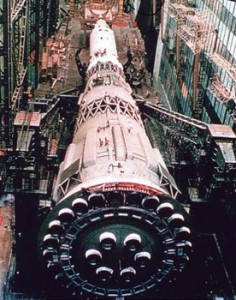N none
The Soviets called it the N1, and kept it secret, of course. What a hard secret that must have been to keep, considering just how awesome this rocket was. A tall, ultra-steep cone, it was a bit more 19th century in appearance, more science fictiony-looking, than the square shouldered and cylindrica…
The Soviets called it the N1, and kept it secret, of course. What a hard secret that must have been to keep, considering just how awesome this rocket was. A tall, ultra-steep cone, it was a bit more 19th century in appearance, more science fictiony-looking, than the square shouldered and cylindrical Saturn V. The N1 was so much more...Soviet looking. It might have been an element of a nuclear power plant, or a tower rising up in the middle of any Eastern-bloc industrial city.

At 345 feet tall, the N1 was only slightly shorter than the Saturn V's 363 feet, and was built for the same purpose—to send people to the moon. The Soviets hadn't mastered large, first-stage rocket engines, so the N1 had 24 rockets arranged in an outer ring at the base of its first stage, and six more in an inner ring, with a total thrust at liftoff of 9.666 million pounds, three million more than that of the strongest Saturn V. The Soviets had not mastered the combustion of liquid hydrogen either, so the vehicle burned only kerosene and liquid oxygen.
The N1's four unmanned launches, between February 1969 and November 1972, all ended in firey failures. The second of these, on July 4, 1969, in the hours after midnight local time at the Baykonur Cosmodrome (still July 3 in Moscow), produced a spectacular detonation as the rocket rose briefly to about 600 feet and collapsed onto the launch pad. The event unleashed an estimated force of 250 tons of TNT, destroyed the launch pad and the surrounding infrastructure, and set the program back two years.
Remarkably no one was killed, as all observers were kept at a safe distance. But Valeriy Menshikov, a young lieutenant in the Strategic Missile Forces who worked as a duty officer that night, later wrote :

At 345 feet tall, the N1 was only slightly shorter than the Saturn V's 363 feet, and was built for the same purpose—to send people to the moon. The Soviets hadn't mastered large, first-stage rocket engines, so the N1 had 24 rockets arranged in an outer ring at the base of its first stage, and six more in an inner ring, with a total thrust at liftoff of 9.666 million pounds, three million more than that of the strongest Saturn V. The Soviets had not mastered the combustion of liquid hydrogen either, so the vehicle burned only kerosene and liquid oxygen.
The N1's four unmanned launches, between February 1969 and November 1972, all ended in firey failures. The second of these, on July 4, 1969, in the hours after midnight local time at the Baykonur Cosmodrome (still July 3 in Moscow), produced a spectacular detonation as the rocket rose briefly to about 600 feet and collapsed onto the launch pad. The event unleashed an estimated force of 250 tons of TNT, destroyed the launch pad and the surrounding infrastructure, and set the program back two years.
Remarkably no one was killed, as all observers were kept at a safe distance. But Valeriy Menshikov, a young lieutenant in the Strategic Missile Forces who worked as a duty officer that night, later wrote :
Only in the trench did I understand the sense of the expression "your heart in your mouth." Something quite improbable was being created all around—the steppe was trembling like a vibration test jig, thundering, rumbling, whistling, gnashing—all mixed together in some terrible, seemingly unending cacaphony. The trench proved to be so shallow and unreliable that one wanted to burrow into the sand so as not to hear this nightmare...the thick wave from the explosion passed over us, sweeping away and leveling everything. Behind it came hot metal raining down from above. Pieces of the rocket were thrown ten kilometers away, and large windows were shattered in structures 40 kilometers away. A 400 kilogram spherical tank landed on the roof of the installation and testing wing, seven kilometers from the launch pad.